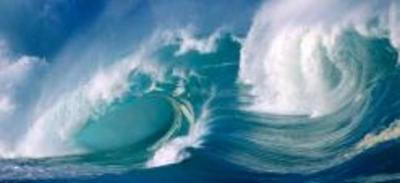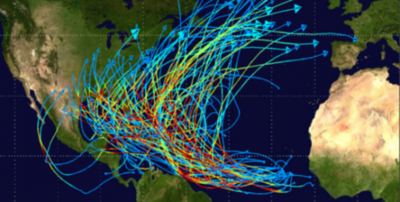Air-Sea Interaction
The exchanges of gases, of heat and of moisture/mass between the atmosphere and ocean are central to the dynamics of both fluids. PAOC researchers are active in developing better understanding of the processes governing these exchanges.
 Transfers of heat, momentum, and trace gases between the earth’s oceans and atmosphere play an important role in weather and climate. One example of the importance of this interaction is the hurricane, which is driven by enthalpy fluxes from the sea and retarded by surface drag. At low wind speeds, the transfer laws are well known and experimentally verified. But at hurricane wind speeds, the sea surface becomes an emulsion and ceases to exist as a topologically well defined interface. In this circumstance, bubble-filled water gives way gradually and continuously to spray-filled air, and very little is known about the transfer of enthalpy, momentum, and important trace gas species through this emulsion. PAOC scientists are attacking this problem through a combination of laboratory and field experimentation. In the laboratory we built an annular wind-wave flume in which air is circulated over a water surface at hurricane wind speeds, and designed techniques to measure with high accuracy the fluxes of enthalpy and momentum between the water and the air. In the field PAOC faculty and students participate in experiments designed to estimate air-sea fluxes at high winds. In one such experiment, instruments mounted on parachutes were deployed from aircraft flying in the eyewalls of mature hurricanes. Measurements from these experiments allow one to calculate the flow of entropy and angular momentum into annuli centered at the storm center, from which the transfer of enthalpy and momentum from the sea surface may be inferred.
Transfers of heat, momentum, and trace gases between the earth’s oceans and atmosphere play an important role in weather and climate. One example of the importance of this interaction is the hurricane, which is driven by enthalpy fluxes from the sea and retarded by surface drag. At low wind speeds, the transfer laws are well known and experimentally verified. But at hurricane wind speeds, the sea surface becomes an emulsion and ceases to exist as a topologically well defined interface. In this circumstance, bubble-filled water gives way gradually and continuously to spray-filled air, and very little is known about the transfer of enthalpy, momentum, and important trace gas species through this emulsion. PAOC scientists are attacking this problem through a combination of laboratory and field experimentation. In the laboratory we built an annular wind-wave flume in which air is circulated over a water surface at hurricane wind speeds, and designed techniques to measure with high accuracy the fluxes of enthalpy and momentum between the water and the air. In the field PAOC faculty and students participate in experiments designed to estimate air-sea fluxes at high winds. In one such experiment, instruments mounted on parachutes were deployed from aircraft flying in the eyewalls of mature hurricanes. Measurements from these experiments allow one to calculate the flow of entropy and angular momentum into annuli centered at the storm center, from which the transfer of enthalpy and momentum from the sea surface may be inferred.
Better understanding of air-sea interaction at high wind speeds is critical to better prediction of hurricane intensity variations, and to attempts to account for the effects that hurricanes have on the ocean.
